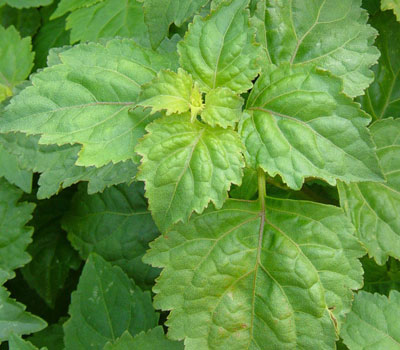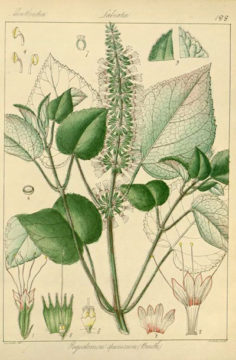FAMILY :: LAMIACEAE (mint family)
100 pesos (small plant)
PATCHOULI, POGOSTEMON CABLIN : A tender, 2′ – 3′ tall, tropical shrub that needs warm, moist, rich soil in sun or part shade and absolutely no frost. It grows well in Vallarta.

The word derives from the Tamil patchai (green), ellai (leaf). In Assamese it is known as xukloti. In Kannada it is known as Pachhethene.
The leaves are the source of the patchouli scent. Either you love it or you don’t. Originally popular in India, patchouli was also the scent used by non-ethnic US and European hippies, ca. 1960s, in their attempts to cover the marijuana smoke scent on their bodies and clothing. It is also the primary scent of India Ink.
I’ve run into many people who state emphatically that they hate patchouli. These people are, by a very large percentage, people who hated “hippies” and the culture of sexual and intellectual freedom that they represented.
The leaves may be eaten as a vegetable or made into a tea.

Medicinally, it has been traditionally used as an anti-depressant, antiphlogistic, antiseptic, aphrodisiac, astringent, cicatrisant, cytophylactic, deodorant, diuretic, febrifuge, fungicide, insecticide, sedative, tonic, cicatrisant, cytophylactic, deodorant, stimulant, and euphoric.
In India the essential oil is used to keep moths and other insects out of linens, woolen shawls and rugs. It is the characteristic scent found in Indian bedspreads and cottons.
Patchouli is a very interesting plant. It’s scent can neither be replaced inorganically nor synthesized because of its complex molecular structure.
MORE INFO
- For a very thorough description of the properties of patchouli, please read this paper from the International Journal of Pharmaceutical Sciences: http://globalresearchonline.net/journalcontents/v21-2/02.pdf.
- #PATCHOULI